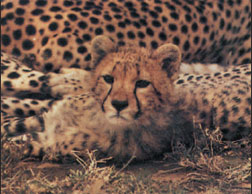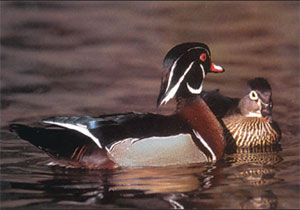Genetic Drift
Genetic Drift
Some species, such as cheetahs (Figure
6-28), contain very little genetic variation,
probably because their ancestral
lineages passed through periods when
the total number of individuals in the
population was very small. A small population
clearly cannot contain large
amounts of genetic variation. Each individual
organism has at most two different
allelic forms of each gene, and a single
breeding pair contains at most four
different allelic forms of each gene. Suppose
that we have such a breeding pair.
We know from Mendelian genetics
(Principles of Genetics:A Review) that chance decides which
of the different allelic forms of a gene
gets passed to offspring. It is therefore
possible by chance alone that one or
two of the parental alleles in this example
will not be passed to any offspring.
It is highly unlikely that the different
alleles present in a small ancestral population
are all passed to descendants
without any change of allelic frequency.
This chance fluctuation in allelic frequency
from one generation to the next,
including loss of alleles from the population,
is called genetic drift.
Genetic drift occurs to some degree in all populations of finite size. Perfect constancy of allelic frequencies, as predicted by Hardy-Weinberg equilibrium, occurs only in infinitely large populations, and such populations occur only in mathematical models. All populations of animals are finite and therefore experience some effect of genetic drift, which becomes greater, on average, as population size declines. Genetic drift erodes the genetic variability of a population. If population size remains small for many generations in a row, genetic variation can be greatly depleted. This loss is harmful to a species’ evolutionary success because it restricts potential genetic responses to environmental change. Indeed, biologists are concerned that cheetah populations may have insufficient variation for continued survival.
Nonrandom Mating
If mating is nonrandom, genotypic frequencies will deviate from the Hardy- Weinberg expectations. For example, if two different alleles of a gene are equally frequent (p = q = .5), we expect half of the genotypes to be heterozygous (2pq = 2 [.5] [.5] = .5) and one-quarter to be homozygous for each of the respective alleles (p2 = q2 = [.5]2 = .25). If we have positive assortative mating, individuals mate preferentially with others of the same genotype, such as albinos mating with other albinos. Matings among homozygous parents generate offspring that are homozygous like themselves. Matings among heterozygous parents produce on average 50% heterozygous offspring and 50% homozygous offspring (25% of each alternative type) each generation. Positive assortative mating increases the frequency of homozygous genotypes and decreases the frequency of heterozygous genotypes in the population but does not change allelic frequencies.
Preferential mating among close relatives also increases homozygosity and is called inbreeding. Whereas positive assortative mating usually affects one or a few traits, inbreeding simultaneously affects all variable traits. Strong inbreeding greatly increases chances that rare recessive alleles will become homozygous and be expressed.
Because inbreeding and genetic drift are both promoted by small population size, they are often confused with each other. Their effects are very different, however. Inbreeding alone cannot change allelic frequencies in the population, only the ways that alleles are combined into genotypes. Genetic drift changes allelic frequencies and consequently also changes genotypic frequencies. Even very large populations have the potential for being highly inbred if there is a behavioral preference for mating with close relatives, although this situation rarely occurs in nature. Genetic drift, however, will be relatively weak in very large populations.
Migration
Migration prevents different populations of a species from diverging. If a large species is divided into many small populations, genetic drift and selection acting separately in the different populations can produce evolutionary divergence among them. A small amount of migration each generation keeps the different populations from becoming too distinct genetically. For example, the French and Russian populations whose ABO allele frequencies were discussed previously show some genetic divergence, but continuing migration between them prevents them from becoming completely distinct.
Natural Selection
Natural selection can change both
allelic frequencies and genotypic frequencies
in a population. Although the
effects of selection are often reported
for particular polymorphic genes, we
must stress that natural selection
acts on the whole animal, not on
isolated traits. An organism that possesses
a superior combination of traits
will be favored. An animal may have
traits that confer no advantage or even
a disadvantage, but it is successful
overall if its combination of traits
is favorable. When we claim that
a genotype at a particular gene has
a higher relative fitness than others,
we state that on average that genotype
confers an advantage in survival
and reproduction in the population. If
alternative genotypes have unequal
probabilities of survival and reproduction,
the Hardy-Weinberg equilibrium
will be upset.
Some traits and combinations of traits are advantageous for certain aspects of an organism’s survival or reproduction and disadvantageous for others. Darwin used the term sexual selection to denote the selection of traits that are advantageous for obtaining mates but may be harmful for survival. Bright colors and elaborate feathers may enhance a male bird’s competitive ability in obtaining mates while simultaneously increasing his vulnerability to predators (Figure 6-29). Changes in the environment can alter the selective value of different traits. The action of selection on character variation is therefore very complex.
Interactions of Selection, Drift, and Migration
Subdivision of a species into small populations that exchange migrants is an optimal situation for promoting rapid adaptive evolution of the species as a whole. Interaction of genetic drift and selection in different populations permits many different genetic combinations of many polymorphic genes to be tested against natural selection. Migration among populations permits particularly favorable new genetic combinations to spread throughout the species as a whole. Interaction of selection, genetic drift, and migration in this example produces evolutionary change that is qualitatively different from what would result if any of these three factors acted alone. Natural selection, genetic drift, mutation, nonrandom mating, and migration interact in natural populations to create an enormous opportunity for evolutionary change; perpetual stability, as predicted by Hardy-Weinberg equilibrium, almost never occurs across any significant amount of evolutionary time.
 |
| Figure 6-28 The cheetah, a species whose genetic variability has been depleted to very low levels because of small population size in the past. |
Genetic drift occurs to some degree in all populations of finite size. Perfect constancy of allelic frequencies, as predicted by Hardy-Weinberg equilibrium, occurs only in infinitely large populations, and such populations occur only in mathematical models. All populations of animals are finite and therefore experience some effect of genetic drift, which becomes greater, on average, as population size declines. Genetic drift erodes the genetic variability of a population. If population size remains small for many generations in a row, genetic variation can be greatly depleted. This loss is harmful to a species’ evolutionary success because it restricts potential genetic responses to environmental change. Indeed, biologists are concerned that cheetah populations may have insufficient variation for continued survival.
Nonrandom Mating
If mating is nonrandom, genotypic frequencies will deviate from the Hardy- Weinberg expectations. For example, if two different alleles of a gene are equally frequent (p = q = .5), we expect half of the genotypes to be heterozygous (2pq = 2 [.5] [.5] = .5) and one-quarter to be homozygous for each of the respective alleles (p2 = q2 = [.5]2 = .25). If we have positive assortative mating, individuals mate preferentially with others of the same genotype, such as albinos mating with other albinos. Matings among homozygous parents generate offspring that are homozygous like themselves. Matings among heterozygous parents produce on average 50% heterozygous offspring and 50% homozygous offspring (25% of each alternative type) each generation. Positive assortative mating increases the frequency of homozygous genotypes and decreases the frequency of heterozygous genotypes in the population but does not change allelic frequencies.
Preferential mating among close relatives also increases homozygosity and is called inbreeding. Whereas positive assortative mating usually affects one or a few traits, inbreeding simultaneously affects all variable traits. Strong inbreeding greatly increases chances that rare recessive alleles will become homozygous and be expressed.
Because inbreeding and genetic drift are both promoted by small population size, they are often confused with each other. Their effects are very different, however. Inbreeding alone cannot change allelic frequencies in the population, only the ways that alleles are combined into genotypes. Genetic drift changes allelic frequencies and consequently also changes genotypic frequencies. Even very large populations have the potential for being highly inbred if there is a behavioral preference for mating with close relatives, although this situation rarely occurs in nature. Genetic drift, however, will be relatively weak in very large populations.
Migration
Migration prevents different populations of a species from diverging. If a large species is divided into many small populations, genetic drift and selection acting separately in the different populations can produce evolutionary divergence among them. A small amount of migration each generation keeps the different populations from becoming too distinct genetically. For example, the French and Russian populations whose ABO allele frequencies were discussed previously show some genetic divergence, but continuing migration between them prevents them from becoming completely distinct.
Natural Selection
 |
| Figure 6-29 A pair of wood ducks. Brightly- colored feathers of male birds probably confer no survival advantage and might even be harmful by alerting predators. Such colors nonetheless confer advantage in attracting mates, which overcomes, on average, the negative consequences of these colors for survival. Darwin used the term “sexual selection” to denote traits that give an individual an advantage in attracting mates, even if the traits are neutral or harmful for survival. |
Some traits and combinations of traits are advantageous for certain aspects of an organism’s survival or reproduction and disadvantageous for others. Darwin used the term sexual selection to denote the selection of traits that are advantageous for obtaining mates but may be harmful for survival. Bright colors and elaborate feathers may enhance a male bird’s competitive ability in obtaining mates while simultaneously increasing his vulnerability to predators (Figure 6-29). Changes in the environment can alter the selective value of different traits. The action of selection on character variation is therefore very complex.
Interactions of Selection, Drift, and Migration
Subdivision of a species into small populations that exchange migrants is an optimal situation for promoting rapid adaptive evolution of the species as a whole. Interaction of genetic drift and selection in different populations permits many different genetic combinations of many polymorphic genes to be tested against natural selection. Migration among populations permits particularly favorable new genetic combinations to spread throughout the species as a whole. Interaction of selection, genetic drift, and migration in this example produces evolutionary change that is qualitatively different from what would result if any of these three factors acted alone. Natural selection, genetic drift, mutation, nonrandom mating, and migration interact in natural populations to create an enormous opportunity for evolutionary change; perpetual stability, as predicted by Hardy-Weinberg equilibrium, almost never occurs across any significant amount of evolutionary time.




